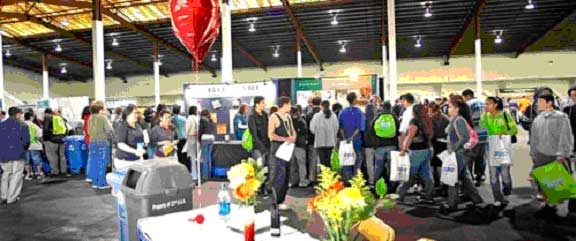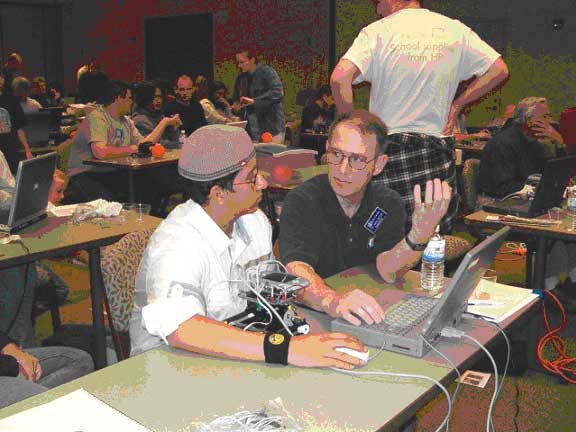Forum on Education of The American Physical Society
Summer 2006 Newsletter
|
The San Diego Science Alliance: Patricia Winter, Nancy Taylor, Christopher M. Smith, Rick Olson The San Diego Science Alliance (SDSA), a 501 (c)(3) non-profit organization, is dedicated to the support of science and math literacy in grades K-12 within San Diego County. The primary goal of the SDSA is to enhance educators' knowledge of local resources for science education. Toward that end, SDSA provides tools and networking opportunities to connect teachers with resources that are available to enrich science education. SDSA also works with local science educators to identify areas of need and to develop new programs for San Diego students and teachers. In addition, SDSA seeks to foster communication among the business community, colleges, and other organizations that support science education. And finally, SDSA strives to create interest in the sciences in the community at large. The San Diego Science Alliance, just starting its eleventh year, has established a dedicated, hands-on board that continues to deliver science opportunities for K-12 teachers and students. The Resource Catalogue of SDSA is recognized by K-12 educators throughout the county as "the" definitive volume of every local resource for Science Educators. It is available in print and on-line at www.sdsa.org. The SDSA has developed and sustained innovative programs that are well recognized for their value. These include an annual High Tech Fair for junior high and high school students and 60 local high tech business and industry exhibitors; the Better Education for Women in Science and Engineering (BE WiSE) program for middle school girls; the Partnerships Involving the Scientific Community in Elementary Schools (PISCES) Project for grades K-6, and most recently the Robotics Program. The Board of Directors of the San Diego Science Alliance has representation from various sectors of local science and engineering related businesses, K-12 educational institutions, universities and community colleges and informal science education institutions. Every member of the Board of Directors is an active volunteer on one or several programs serving K-12 science teachers and students. The stories of two companies that participate in these programs are described below. High Tech Fair Participation by the UCSD Center for Theoretical Biological Physics The Center for Theoretical Biological Physics (CTBP) at the University of California San Diego is an NSF-funded Physics Frontier Center facility charged with conducting leading-edge research at the interface of biology and physics. Part of our mission is training and encouraging new scientists, especially K-12 students, to pursue studies in science and mathematics. Mimicking CTBP research, we decided to present fundamental chemistry and physics concepts in the context of biological phenomena. We wanted to demonstrate to young learners the connection between physics, chemistry and mathematics and what we observe and use everyday, e.g., vision. Since much of our research work is based upon computer simulations and modeling, we used multi-media and molecular visualization tools in our presentation. We demonstrated how light (a wave of energy) is focused onto the retina of the eye, absorbed by the retinal molecule embedded in the protein rhodopsin, and how the subsequent conformational change of rhodopsin causes a nerve impulse (vision). Once students understood the basic process, they were free to virtually explore the intricate features of the rhodopsin protein with a molecular modeling program. We wanted to reinforce the idea that computers and computer graphics aren't just for gaming: one can actually do some real modeling and discovery using their desktop PC. In addition, we also wanted our learners to gain self-confidence over their knowledge. That is, the self-realization that "I can understand this, I can do this [science]." As scientists, the interactions with the young learners provided an opportunity for us to step back from our centric molecular and the atomic views, and think about the relevance of our basic research to the common man, towards the betterment of society. We were able to experiment and build new pathways to communicate with learners, young and old. We look forward to hosting another CTBP learning activity at next year's SDSA High Tech Fair. LEGO robotics competition participation by the University of San Diego A few years ago, I (R.O.) agreed to help officiate at a FIRST LEGO League robotics competition. It seemed like a nice way to spend a Saturday. As an engineering faculty member at the University of San Diego (USD), I'd be able to encourage some 3rd-8th grade students and maybe some of them would eventually become engineers. At the end of the day, I'd return to my usual routine. That day I herded students from one venue to another as they gave presentations, modified their robots, compared designs with students from other schools and, incidentally, competed with their robots. The excitement was palpable. It didn't matter how their robots actually did in the competition, what mattered was that it was their robot and it did something. Ten year olds had built autonomous, programmed robots that roll, turn, lift, and drag. These kids were excited, funny, engaging, enthusiastic and appreciative. I was hooked. That spring I volunteered at the Southern California Botball competition for 7th-12th grade students. The kids were older, the robots were more sophisticated, and the desire to win was stronger, but again the predominant mood among the students was celebration. They designed the robot, they wrote the programs (in C no less), they learned how to use servos and photosensors, and they discovered unexpected ways of solving problems. There were 30 teams and 30 different ways of doing things. And they were all great. In the afterglow I suggested that the Botball tournament be held at USD. This has entailed a fair amount of work at time, but that pales compared to the psychic payback I get from working with and, truth be told, learning from the kids. When someone shouts as their robot follows a line for the first time I'm reminded of the joy of learning new things. Watching eight students huddle around a broken 'bot reinforces the importance of teamwork and that everyone has something important to contribute. And now, as robot season rolls around, I look forward to seeing the students again -- the new faces and those who are back for more. From them, and for me, robotics has become the usual routine.
The San Diego High Tech Fair
The San Diego High Tech Fair
The Center for Theoretical Biological Physics exhibit at the San Diego High Tech Fair
During Botball workshops volunteers like Rick Olson help students learn to build and program their first robots Patricia Winter is the founder and former Executive Director of the San Diego Science Alliance. She can be reached at Pat.Winter@gat.com. Nancy Taylor is the Science Coordinator at the San Diego County Office of Education and an SDSA Board Member. She can be reached at ntaylor@sdcoe.net . Christopher M. Smith is the Associate Director for Education, Outreach and Training for CTBP, and can be reached at csmith@ctbp.ucsd.edu. Dr. Rick Olson is an Associate Professor of Industrial and Systems Engineering at the University of San Diego. He can be contacted at r_olson@sandiego.edu. |



